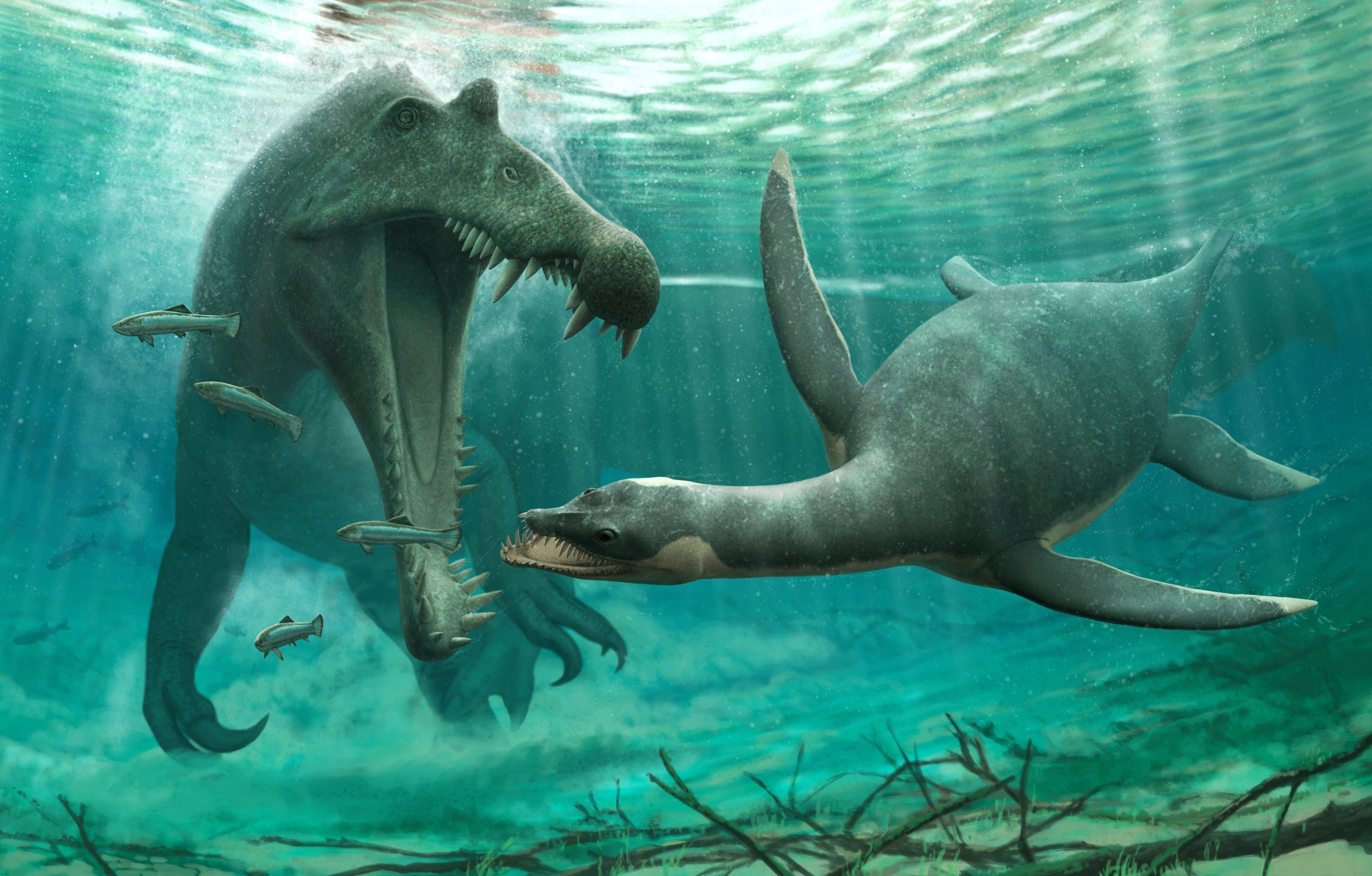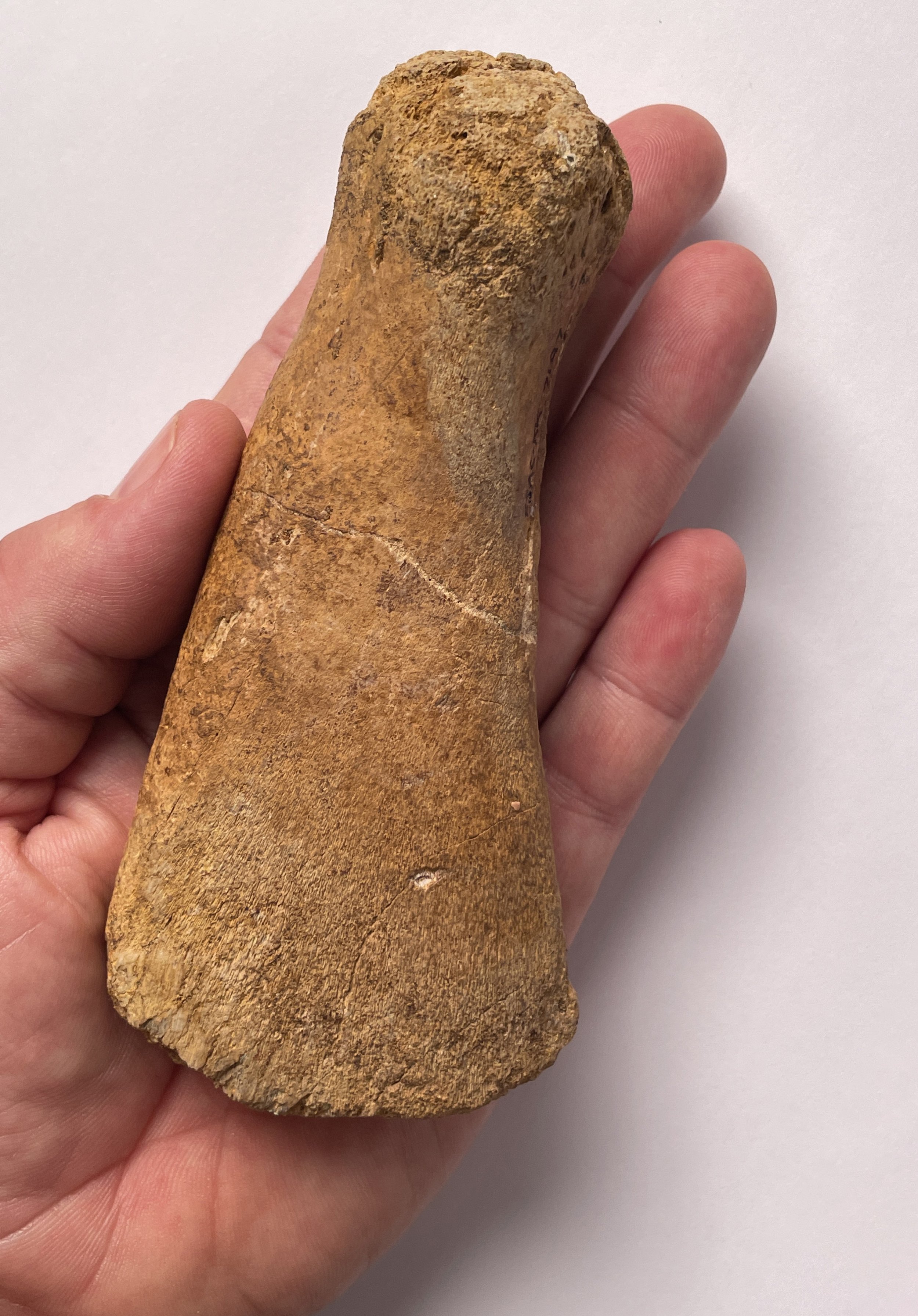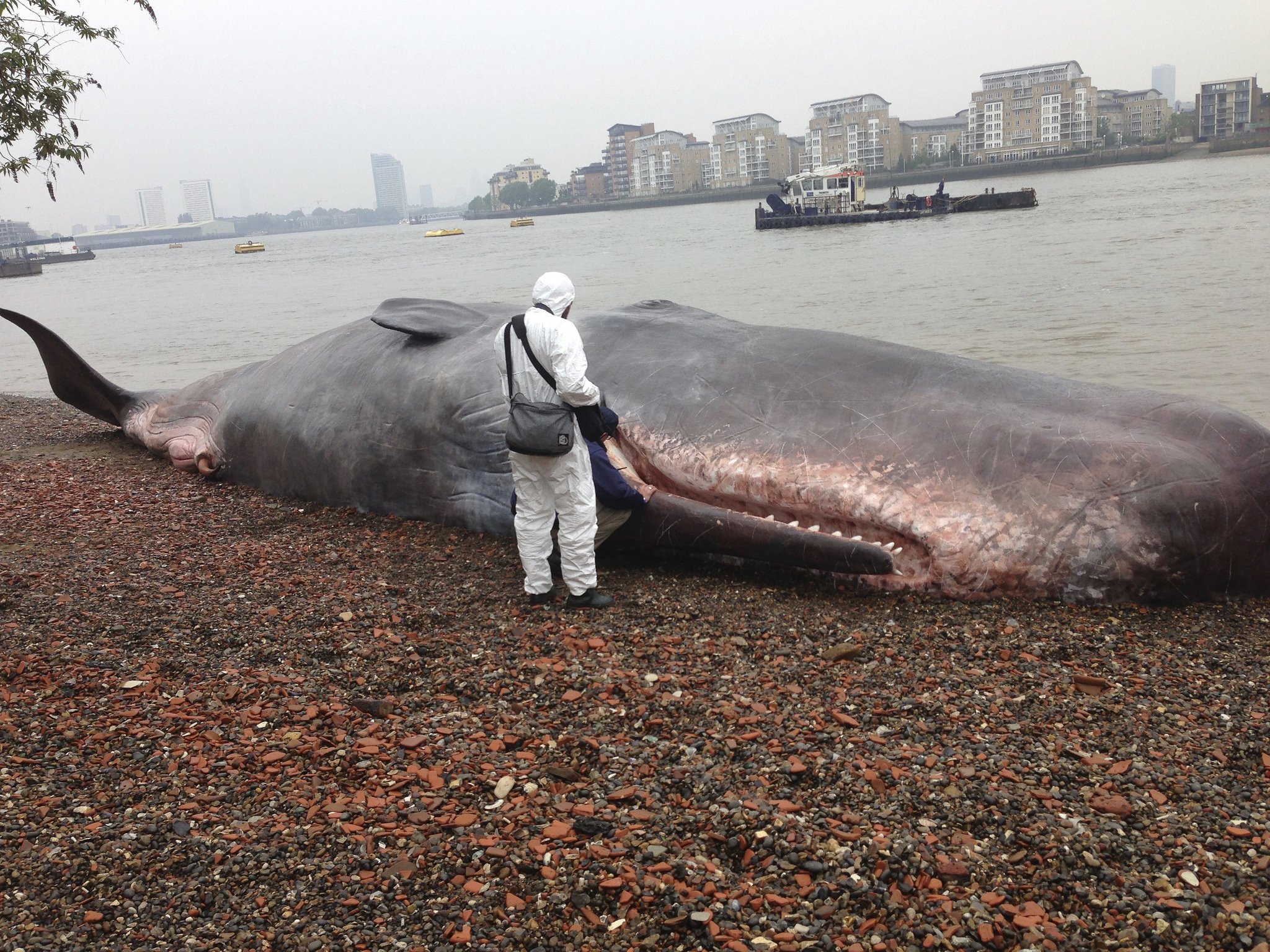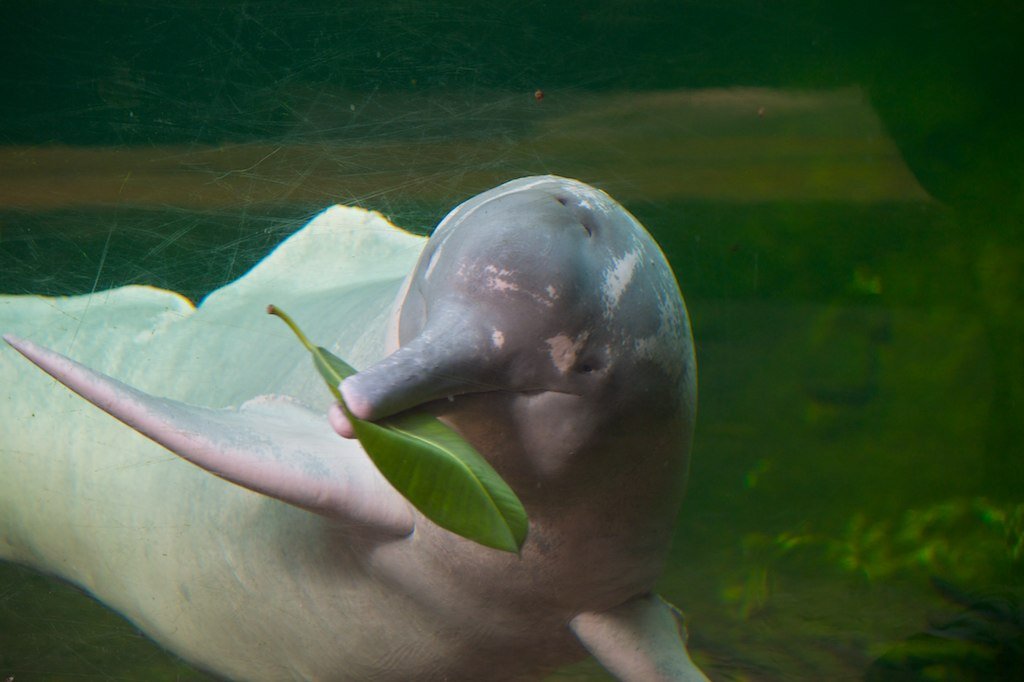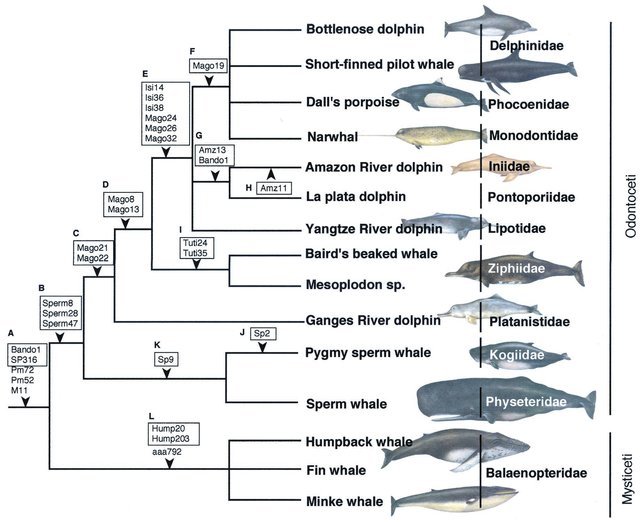What were marine reptiles doing in a 100 million year old river?
New fossils from the Cretaceous of Morocco show plesiosaurs lived in an ancient river system, along with frogs, crocodiles, turtles, and the giant aquatic dinosaur Spinosaurus.
A small leptocleidid plesiosaur in the Kem Kem risks becoming food for the aquatic dinosaur Spinosaurus
Plesiosaurs are marine reptiles. Marine reptiles are marine, which is why we call them “marine reptiles” and not “non-marine reptiles.” So why would marine reptiles be in a non-marine environment- a freshwater river system? That’s what I wondered when I came across a small plesiosaur bone from the Kem Kem beds of Morocco.
arm bone from a leptocleidid plesiosaur, mid- Cretaceous (Cenomanian) Kem Kem beds of Morocco
The fossil in question was a triangular hunk of bone. mixed in amongst various fossils, in a small rock shop in Erfoud, on the edge of the Sahara. I probably wouldn’t have paid it any attention, but the day before I’d been looking at a fairly complete plesiosaur skeleton from the Turonian of the Akrabou Formation. The image of those strange plesiosaur bones was still fresh in my head, and I was hit with recognition.
This was a plesiosaur- a marine reptile- but it was in the Kem Kem beds. And plesiosaurs really shouldn’t be there, because the Kem Kem wasn’t deposited in the sea. It’s freshwater, an ancient, Cretaceous-aged river system.
100 million years ago, the Sahara of Morocco was a very different place. A vast system of rivers flowed north out of Africa and emptied into the Atlantic Ocean. In the sands and clays laid down by those rivers, we find a rich fauna of fish and other aquatic animals. These include huge lungfish, giant coelacanths, bowfin, freshwater-tolerant sharks and rays, frogs, salamanders, turtles, crocodilians, and a huge aquatic dinosaur, Spinosaurus. The diversity and sheer size of some of these fish suggests that this river system was highly productive, and very large.
A selection of Kem Kem aquatic taxa, with Homo sapiens for scale
Although the ocean was close by to the north, we know these beds were deposited in freshwater. That’s because they’re full of animals that can’t survive in saltwater- frogs, salamanders, lungfish, and a family of mussels, the Unionidae, that occur only in freshwater. And now, along with them, we had a plesiosaur.
Mesozoic Marine Reptiles
Plesiosaurs are your classic marine reptiles. The first plesiosaur skeleton was found back in 1823 by Mary Anning, in Jurassic rocks. Plesiosaurus was a bizarre creature, not like anything alive today — it had a toothy little head on a long, snaky neck, with a fat body, a short tail, and four long flippers.
In Anning’s sketch you can also see a number of features of their distinctive anatomy- blocky, triangular limb bones, dozens of bones in the fingers and toes to support those long paddles. The individual bones of a plesiosaur skeleton are also very weird compared to other reptiles. They have a remarkably simplified structure. It’s as if the design of the animal was handed over to a small child, who proceeded to draw the anatomy in crayon.
Anyway, the beds in Lyme Regis that produced Plesiosaurus are marine rocks. We know that because they’re full of fossils of marine animals, like ammonites and belemnites. So Plesiosaurus was a marine animal. And since then, over a hundred species of plesiosaur have been discovered. These are animals like the giant predators Kronosaurus and Liopleurodon, the ultra-long-necked Elasmosaurus, the long-snouted Dolichorhynchops. And those animals, like the vast majority of plesiosaur fossils, come from marine rocks. You find them shales, sandstones, limestones and chalks laid down in Mesozoic seas. Plesiosaurs more rarely show up in brackish or estuarine settings, and even more rarely, in freshwater.
What’s a plesiosaur doing in the Kem Kem?
It seemed possible that this little bone from a plesiosaur flipper was a one-off, a fluke. That seemed unlikely to me, however. My hunch- though it was nothing more than that- was that there were more plesiosaur fossils to be found, and we should look for them.
In the meantime, my student Georgina Bunker, studied the bone, and figured out that it was a humerus (which was better than I had been able to do) and wrote it up as a final-year undergraduate project. My colleague, Dave Martill, was later able to recognize our plesiosaur as a member of Leptocleididae- a family of small plesiosaurs, which typically growing around 3 meters long. And curiously- and unusually for plesiosaurs- Leptocleidids are often known from nonmarine beds, like the freshwater Wessex Formation and the brackish Vessex Formation of England.
Over the next couple of years, we kept an eye out and more plesiosaur appeared, confirming our suspicion that these things might be common in the Kem Kem.
A leptocleidid plesiosaur back vertebra. The big openings for the arteries on the bottom are typical of plesiosaurs.
After the humerus, several vertebrae turned up. Like the limb bones, plesiosaur vertebrae are distinctive if you know what to look for. If you don’t, they seem utterly unremarkable- like some sort of generic reptile vertebra, crude cylinders of bone with few features. That means if you if you’re not actively looking for them, or not a plesiosaur expert, they don’t catch your eye. It was only once we started actively hunting that we found them. Eventually we came up with one vertebra from the neck, one from the back, another from the tail.
What about teeth? Plesiosaur teeth are slender, curved spikes with lots of little ridges. This, however, characterizes the teeth of all kinds of fish-eating animals- Spinosaurus, crocodilians, and fish-eating pterosaurs like Anhanguera and Ornithocheirus. Long curved spikes with lots of ridges are good for spearing fish. And so lots of different fish-eating animals, not just plesiosaurs, evolved that tooth shape.
A leptocleidid plesiosaur tooth from the Kem Kem beds of Morocco
Plesiosaur teeth are only subtly different from those of other fish-eating reptiles. They have an odd, sigmoidal curvature, where the crown curves back, then curves forward at the tip. There’s also a strong cutting edge or carina on the front of the tooth, but only a weak one on the back. Them there’s lots of little enamel ridges on the inside of the tooth, but few on the outside. Last, they have an oddly smooth, almost glassy enamel unlike the textured enamel of spinosaurs. Again, once we knew what to look for- and that we should look- they started turning up, but until then they were easy to overlook, and mistake for small spinosaur or crocodilian teeth.
So once we knew what the teeth looked like (almost but not quite like Spinosaurus and crocodiles) rummaging through a box of several hundred teeth produced eight little plesiosaur teeth.
Curiously, all the Kem Kem fossils are from small animals. The biggest might have been around 3 meters, or 10 feet in length. The smallest bone- that humerus- comes from an animal about half that size, maybe 1.5 meters or 5 feet long. Since everything we saw is pretty small— and all known leptocleidids were small— it’s unlikely they got much bigger.
The Kem Kem plesiosaur turns out to be, if not common, not ridiculously rare, either. They’re a consistent presence in the Kem Kem beds. You need to go through a lot of bones to find them, but they’re reliably there. So the question becomes, why? Why would a marine reptile be found in freshwater?
Well, a good place to start answering that question might be to look at why modern marine lineages enter freshwater.
Why do marine animals enter freshwater?
Most saltwater animals can’t survive in freshwater. Take a saltwater fish like a lionfish or a clownfish, toss it into a freshwater aquarium, and it will die. Neither do marine animals like whales and sea turtles enter freshwater very often, or tolerate it well. Still, they do enter freshwater, for various reasons.
Sometimes, they enter freshwater because they’re lost, or sick, and can bestranded there and die.
Sometimes, they briefly enter freshwater to forage.
A few species can tolerate both saltwater and fresh water, and so spend part of their lives in each.
And a few marine lineages adapted to life in freshwater, and spend their whole lives there.
Strandings
Sometimes whales wander up into an estuary or a river. This often seems to happen to whales that are sick or injured. It’s possible they’re trying to find a safe place to recover, without predators. Or maybe they’re just lost. A humpback was observed wandering up the Sacramento River in California, a killer once wandered 100 miles up the Columbia River, and in one remarkable case, a minke whale wandered 1000 kilometers up into Amazon.
Once they’re up in freshwater, however, whales often become sick. Adapted to the salty water of the ocean, the electrolytes in their bodies get out of balance. They often become dehydrated. Their skin can be irritated by freshwater and develop sores, possibly because the freshwater disrupts the skin microbiome, which is adapted to saltwater. Without the right prey to feed on, they probably start to starve. And whales can also easily become stranded in the shallow waters of a river.
A sperm whale stranded in the River Thames
So whales entering freshwater often end their lives there. That’s what happened to a bottlenose whale that entered the River Thames. It became sick, then died as people attempted a rescue. Other whales have also been found stranded and dead in the Thames, including humpback whales, fin whales, and sperm whales.
Remarkably, there are freshwater strandings in the fossil record.
In East Africa, a beaked whale was found in Kenya, 500 miles / 700 km, from the ocean. Found in river sandstones, with fossils turtles and crocodiles, it dates to 17 million years ago. Beaked whales, of the family Ziphiidae, are specialized deep-divers. They plunge thousands of feet into the ocean, and use their toothless jaws to suck up squid. So the animal is unlikely to have lived in a river. Instead, like that bottlenose whale from the Thames (also a member of the Ziphiidae) it became lost, wandered upstream, and died.
The Kenyan beaked whale was a one-offs, a fluke. No other whale fossils were found in these beds. The animals didn’t live here. It was lost and lonely, wandering in a strange and hostile environment, then died there. Could our little plesiosaurs represent something similar— ill-fated wanderers?
Maybe.
If it was just the single humerus, I’d say so. But we have nearly a dozen plesiosaur bones and teeth from the Kem Kem. That’s harder to explain as strandings.
Now, that might not seem like a lot of fossils. But as these are dissociated fossils, they represent 11 different individuals found in this river. Most plesiosaur species are known from just a few fossils, even one. In terms of number of individuals, this is one of the better-known plesiosaurs out there. Finding all these individuals suggests they routinely spent time in the river.
Kem Kem plesiosaur teeth
And bones and shed teeth tell us different things. Bones are buried after an animal dies. So they tell us an animal’s ultimate fate - where it died, or at least, where the body was buried. Shed teeth are lost while the animal lived. So they tend to reflect where animals lived.
What’s more, the two scenarios- our plesiosaurs straying into freshwater, versus living there routinely- make different predictions. Imagine a marine plesiosaur became lost, swam up a river, and died a couple weeks later. In this scenario, it leaves behind hundreds of bones, plus the teeth rooted in the jaws. But being upstream for such a short time, it would shed few teeth, or none. So strandings leave lots of bones and rooted teeth, but few shed teeth. On the other hand, animals inhabiting freshwater would lose hundreds or thousands of teeth over their lifetime- lots of shed teeth.
And so far, we have lots more teeth than bones. That hints that our plesiosaurs spent a lot of time living in freshwater.
An interesting test of this idea involves the rare dinosaurs found in marine beds. In the late Cretaceous phosphates of Morocco, a marine deposit, you get the abelisaur Chenanisaurus, the little duckbill Ajnabia, titanosaurs. Around ten specimens are known.
The jaw of Chenanisaurus barbaricus was found in a marine deposit in Morocco
Every one of these dinosaur fossils is a fragmentary skeleton, an isolated bone, or a rooted tooth- one that fell out of the jaws of a rotting carcass. Not one single shed tooth, lost by a living animal, has turned up. Likewise, dinosaurs in marine rocks elsewhere- Hadrosaurus, Claosaurus- occur as bones and skeletons, not shed teeth.
So sometimes dinosaurs drowned in the ocean, or were washed out to sea and buried. But the absence of shed teeth shows they didn’t live in the sea. That’s unsurprising. Dinosaurs are supposed to be land animals. Still, it’s a neat test. While shed teeth aren’t as impressive as skeletons, they can give you information skeletons can’t.
Opportunistic foraging
Another, more likely possibility, is that plesiosaurs briefly moved into freshwater to feed. Lots of marine mammals do this today. Killer whales, seals, even minke whales sometimes enter estuaries and river mouths to feed on fish. But while this is a possibility, fossils of killer whales, seals, and minke aren’t common in freshwater beds. Which raises the question of why our plesiosaurs are.
A seal in the River Mersey dines on a pike
What’s more, our shed teeth provide another form of evidence of behavior— tooth wear. Almost all Kem Kem plesiosaur teeth are heavily worn, chipped, or broken. That’s unusual for plesiosaurs. But it’s typical of Spinosaurus teeth in the Kem Kem. That hints that our little plesiosaurs routinely ate the same stuff as the spinosaurs.
And those spinosaurs, presumably, damaged their teeth on the massive, bony scales of lepidotid fish, the bony skulls of lungfish and coelacanths, and the rough denticles of freshwater sharks. The fact that the plesiosaurs had tooth wear similar to other animals in that river suggests they’re going up the rivers routinely, not just on occasion.
Freshwater tolerance
Some aquatic animals are what’s called euryhaline- they can tolerate a range of salinities, from saltwater to fresh. Some fish and sharks are like this- sticklebacks, for example, and bull sharks. Various fish species- lampreys, salmon, eels- may spend part of their lives in the sea, and part in freshwater.
And among modern marine mammals, a number of species evolved to tolerate both salt and freshwater.
One is the Beluga whale, which routinely enters river mouths to feed, and sometimes wanders a hundred miles up into rivers. The Irrawaddy Dolphin in southeast Asia, and the La Plata river dolphin in South America, can exploit both freshwater and marine habitats.
Manatees represent a marine lineage that evolved to tolerate freshwater environments.
An Irrawaddy Dolphin, Orcaella brevirostris, in the Mekong River (Wikipedia)
The idea that the Kem Kem plesiosaurs were euryhaline is certainly a plausible explanation for the data. I think does a better job of explaining the plesiosaurs’ abundance in freshwater than the idea that they’re just lost, or opportunistically feeding in freshwater.
Still, there are issues with this idea. The big problem is that we’d expect an animal that used both freshwater and salt water to occur in both freshwater and salt water. So far there’s no evidence that this species lived in salt water; the Kem Kem plesiosaur is found only in Kem Kem; nothing like it is known in contemporary marine rocks. If these animals were moving back and forth between marine and freshwater… well, why aren’t they in any marine rocks of similar age?
Or for that matter, why doesn’t this lineage occur in other river systems in Africa? Plesiosaurs occur in similar aged nonmarine rocks in Bahariya, in Egypt. But curiously, they aren’t leptocleidids. They represent another family, Polycotylidae. That’s not what you’d expect if the Kem Kem animals could move from freshwater, into marine, and back- you’d expect them to be widespread. Of course, their fossils could always turn up elsewhere… but so far they haven’t.
Freshwater adaptation
There’s one final possibility, which I argue is the simplest explanation that fits the facts. These marine reptiles occur requently (and exclusively) in freshwater beds because they’re not really marine reptiles. They may be freshwater specialists, like river dolphins.
I admit this hypothesis is tentative. Obviously, the simplest hypothesis that fits the facts isn’t always right. In science, new facts often come along and spoil our neat, simple explanations (one of the reasons that it’s much easier to work with theories, than facts). Still, I think it’s worth taking this hypothesis seriously.
Consider marine mammals. Several species are adapted to live in freshwater, and only live there. There’s Platanista, the river dolphins of the Ganges and Indus in India, There are two different genera of dolphin in the Amazon, Inia and Sotalia. And until a few years ago, there was the Yangtze river dolphin or Baiji, Lipotes†.
Amazon River Dolphin, Inia, playing with a leaf
What’s remarkable is that these four genera are unrelated- river dolphins evolved over and over and over. At least four different marine lineages moved into freshwater and became freshwater specialists.
There are also non-marine seals- the Baikal Seal, or nerpa, spends its whole life in Lake Baikal, in Siberia- around 1000 miles / 1500 km from the ocean. The Caspian Seal meanwhile lives in the brackish waters of the Caspian Sea.
Baikal Seal, or nerpa, on the shores of Lake Baikal
So, is our plesiosaur adapted to life in freshwater, like a river dolphin?
Maybe.
This hypothesis does fit the available facts. Now, that doesn’t mean it’s right. We could find fossils that prove these plesiosaurs lived in saltwater, too. Obviously, as new evidence emerges, we may need to revise our hypotheses. That’s just what it means to do science- we never know anything for certain, as our hypotheses are always potentially falsifiable by new observations.
More fossils would be helpful here. And it should be possible to study the chemistry of the teeth. Depending on whether the animals lived and fed in freshwater, saltwater, or a mix, their chemical composition should reflect the chemistry of the waters they lived in. This is still early days, however, so those studies haven’t been done yet.
So I don’t have high confidence in this hypothesis. But it does fit the evidence. These animals seem to have spent lots of time in the river, and there’s (so far) no evidence they lived anywhere else.
I’d be willing to bet a beer that the animal was a freshwater specialist, but not a million dollars.
Is this speculative?
Well, yes.
But it’s the nature of paleontology to be speculative. We’re trying to understand the biology, ecology and evolution of animals that died millions of years ago. Almost all relevant information has been lost. The skin and muscles and soft tissues have decayed. The DNA has degraded. Even the vast majority of skeletons, bones and teeth were destroyed instead of fossilized.
We still know very little about the past- and a lot of what paleontologists claim to be conclusive knowledge is often just speculation dressed up with fancy analyses, statistics, and computer models to make our conclusions seem less speculative and tentative than they really are. A lot of academia, I’d argue, involves projecting confidence about things we don’t really know. I mean, if we had the slightest idea what was going on, we wouldn’t constantly be finding new fossils that upended our existing theories, and we wouldn’t even need to go out and collect new fossils.
And if we don’t speculate, how do we know which data to collect to shoot down- or verify- our hypotheses?
Nonmarine Marine Reptiles
I was a bit surprised to realize that our Kem Kem plesiosaurs are far from unique. Although the vast majority of marine reptiles are (as the name suggests) marine, plesiosaurs were long-lived and widespread, and over the Mesozoic, a surprising number do show up in non-marine settings- especially the Leptocleididae.
In fact, most occurrences of the family Leptocleididae are from in nonmarine rocks— rivers, estuaries, brackish lagoons. Leptocleidids seem to be more common in non-marine settings than marine ones. The implication is that the whole family may be adapted to exploit shallow environments and able to tolerate freshwater to some degree.
Other plesiosaurs show up in nonmarine rocks too, around the world. Rhomalaeosaurs are in freshwater beds in China in the Jurassic. Elasmosaurs appear in nonmarine beds in Canada and Argentina in the Cretaceous. Polycotylids occur in nonmarine rocks rarely, with some known from a mangrove in Egypt and one from Argentina. Pliosaurs seem to be rare in freshwater, however.
There’s probably not a single explanation for all the non-marine plesiosaurs. Odds are, some must be marine animals lost up rivers. Some species might be euryhaline. But given just how many different non-marine occurrences there are over the Mesozoic, it seems likely that at least some- maybe including our Kem Kem animal- were freshwater specialists.
Other Mesozoic marine groups occur more rarely in freshwater settings.
One species of mosasaur, Pannoniasaurus, seems to be a freshwater specialist, but mosasaurs otherwise don’t occur in freshwater. Teleosaurids, a primarily marine crocodilian lineage, occur in freshwater beds in Thailand. Curiously, ichthyosaurs- among the most diverse and long-lived marine reptiles groups- are unknown from freshwater. I have no idea why.
The Marine to Freshwater transition: an evolutionary dead end?
The transition between freshwater and marine environments is a major adaptive barrier that has to be overcome before an animal can become fully marine. That’s probably part of why so few tetrapod lineages have managed to become fully specialized to marine habitats. Over the past 250 million years, a complete land-to-sea transition, with animals living and reproducing in the ocean, has only happened a handful of times. Plesiosaurs, ichthyosaurs, mosasaurs, palaeophiid sea snakes, modern sea snakes, whales, and sirenians. That’s more often than powered flight has evolved, but still, it’s a complex transition that evolves rarely.
The land-to-sea transition is a complex transition because it requires animals to adapt to solve a whole host of problems. How to control their bouyancy, so that they sink instead of float. How to propel themselves and maneuver underwater. How to catch food underwater. How to navigate and hunt in water. How to breed in water.
And how to survive in highly saline water.
For an animal adapted to drink freshwater, the sea is a sort of desert- it’s got water, but no drinkable water. Sort of like in Dune, you need specializations to be able to survive in that kind of harsh environment.
A marine iguana ejects excess salt from nasal salt glands (National Geographic)
Marine reptiles and birds adapt to marine life in part by developing the ability to excrete excess sodium- using salt glands. Marine iguanas can excrete salt through the nose. Sea snakes have glands in the mouth. Many marine birds have salt glands in the eyes. It’s likely plesiosaurs evolved salt glands too, although they wouldn’t fossilize, so we can’t know. There might be be other adaptations as well. Sea snake skin is largely impermeable to salt, for example. They are also able to reclaim water from their excretions, so they don’t waste too much. Sort of like the stillsuits in Dune, perhaps.
The spice must flow (Dune, 1984)
The ability to survive in saltwater is one of a series of barriers, a threshold animals must cross to become marine.
But coming back into freshwater after millions of years in the sea, creates its own challenges- an animal that has spent millions of years adapting to salty waters is no longer well-adapted to surviving in fresh water. Crossing the adaptive threshold of salt-tolerance has created a new adaptive threshold, one of freshwater tolerance.
And the interesting thing here is, for marine lineages, going back is often a one-way trip. Once you’re re-adapted to freshwater, you’re now restricted to a small habitat- a single river drainage. You can’t access other river drainages since the ocean connecting them is now a hostile, largely impassable environment.
As a result, freshwater marine mammals evolved repeatedly. Evolution has to solve the same problem- freshwater adaptation- over and over and over again. River dolphins didn’t just evolve once- they evolved four times, with four different whales lineages moving into freshwater. And fossils from Columbia dating to the Miocene, around 12 million years ago, hint at a fifth invasion.
The problem is that once they’re in freshwater, it’s hard to get into another river system. Since river dolphins don’t saltwater well, they have no way move to other rivers. So when dolphins colonize a new river system, it’s a marine dolphin moving into a freshwater environment, not a river dolphin moving into a river. It’s not inconcievable that dolphins could re-evolve saltwater tolerance- but for some reason they don’t, maybe because competing marine dolphins and porpoises already fill those marine niches well.
This pattern is analogous to island flightlessness in birds. Flightless birds evolved repeatedly on islands because once they became flightless on an island, they couldn’t reach any other island. Evolution produced flightless birds repeatedly- kiwis, elephant birds, rheas, cassowaries, moas, kakapos, dodos, takahes, moa-nalos, over and over, since kiwis in New Zealand could hardly get to Hawaii to exploit the habitats there, and even flightless ducks on Maui couldn’t get to Hawaii, so instead geese colonized Hawaii and became flightless. Insular flightlessness is a dead-end. It lets you occupy that particular habitat, but closes you off to anything outside that island, since you lose your dispersal ability. In the same way, a freshwater habitat of a river is like an island. Adaptation to that small habitat cuts you off from exploiting similar habitats elsewhere, it limits your dispersal.
Could something similar be going on with plesiosaurs? Maybe one reason lots of different plesiosaur groups- rhomalaeosaurs, polycotylids, elasmosaurs, leptocleidids- show up in different nonmarine settings is that plesiosaurs repeatedly invaded rivers from the sea, like river dolphins. Maybe that’s why we have one family of plesiosaur in a river Morocco- the Leptocleididae- and at the same time, another family in nonmarine settings in Egypt.
Again, I don’t have high confidence in this idea- I’ll bet you a beer it’s true. It’s just a hunch, an idea I think might be worth testing. But plesiosaurs were around for over 100 million years- far longer than whales- so they seem to have had abundant opportunities to exploit a range of habitats and niches- including freshwater, so it might not be too surprising if they did.
The Paper
You can find the paper here: Georgina Bunker, David M. Martill, Roy Smith, Samir Zourhi, Nick Longrich. 2022. Plesiosaurs from the fluvial Kem Kem Group (mid-Cretaceous) of eastern Morocco and a review of non-marine plesiosaurs. Cretaceous Research.
References
Arden, T.M., Klein, C.G., Zouhri, S., Longrich, N.R., 2019. Aquatic adaptation in the skull of carnivorous dinosaurs (Theropoda: Spinosauridae) and the evolution of aquatic habits in spinosaurids. Cretaceous Research 93, 275-284.
Feduccia, A., 1999. The Origin and Evolution of Birds, 2nd ed. Yale University Press, New Haven.
Hamilton, H., Caballero, S., Collins, A.G., Brownell Jr, R.L., 2001. Evolution of river dolphins. Proceedings of the Royal Society of London. Series B: Biological Sciences 268, 549-556.
Kear, B.P., Barrett, P.M., 2011. Reassessment of the Lower Cretaceous (Barremian) pliosauroid Leptocleidus superstes Andrews, 1922 and other plesiosaur remains from the nonmarine Wealden succession of southern England. Zoological Journal of the Linnean Society 161, 663-691.
Kinze, C.C., Czeck, R., Herr, H., Siebert, U., 2021. Cetacean strandings along the German North Sea coastline 1604–2017. Journal of the Marine Biological Association of the United Kingdom 101, 483-502.
Longrich, N.R., Pereda-Suberbiola, X., Jalil, N.-E., Khaldoune, F., Jourani, E., 2017. An abelisaurid from the latest Cretaceous (late Maastrichtian) of Morocco, North Africa. Cretaceous Research 76, 40-52.
Longrich, N.R., Pereda-Suberbiola, X., Pyron, R.A., Jalil, N.-E., 2021. The first duckbill dinosaur (Hadrosauridae: Lambeosaurinae) from Africa and the role of oceanic dispersal in dinosaur biogeography. Cretaceous Research 120, 104678.
McClain, A.M., Daniels, R., Gomez, F.M., Ridgway, S.H., Takeshita, R., Jensen, E.D., Smith, C.R., 2020. Physiological effects of low salinity exposure on bottlenose dolphins (Tursiops truncatus). Journal of Zoological and Botanical Gardens 1, 61-75.
McGowen, M.R., Tsagkogeorga, G., Álvarez-Carretero, S., Dos Reis, M., Struebig, M., Deaville, R., Jepson, P.D., Jarman, S., Polanowski, A., Morin, P.A., 2020. Phylogenomic resolution of the cetacean tree of life using target sequence capture. Systematic Biology 69, 479-501.
Motani, R., Vermeij, G.J., 2021. Ecophysiological steps of marine adaptation in extant and extinct non‐avian tetrapods. Biological Reviews 96, 1769-1798.
Sato, T., Eberth, D.A., Nicholls, E.L., Manabe, M., 2005. Plesiosaurian remains from non-marine to paralic sediments, in: Currie, P.J., Koppelhus, E.B. (Eds.), Dinosaur Provincial Park: A Spectacular Ancient Ecosystem Revealed. Indiana University Press, Bloomington, pp. 249-276.
Schmidt-Nielsen, K., Fange, R., 1958. Salt glands in marine reptiles. Nature 182, 783-785.
Smith, A.J., Higdon, J.W., Richard, P., Orr, J., Bernhardt, W., Ferguson, S.H., 2017. Beluga whale summer habitat associations in the Nelson River estuary, western Hudson Bay, Canada. PLoS One 12, e0181045.
Stacey, P.J., Leatherwood, S., 1997. The Irrawaddy dolphin, Orcaella brevirostris: a summary of current knowledge and recommendations for conservation action. Asian Marine Biology 14, 195-214.
Suarez, C., Gelfo, J.N., Moreno-Bernal, J.W., Velez-Juarbe, J., 2021. An early Miocene manatee from Colombia and the initial Sirenian invasion of freshwater ecosystems. Journal of South American Earth Sciences 109, 103277.
Wichura, H., Jacobs, L.L., Lin, A., Polcyn, M.J., Manthi, F.K., Winkler, D.A., Strecker, M.R., Clemens, M., 2015. A 17-My-old whale constrains onset of uplift and climate change in east Africa. Proceedings of the National Academy of Sciences 112, 3910-3915.
